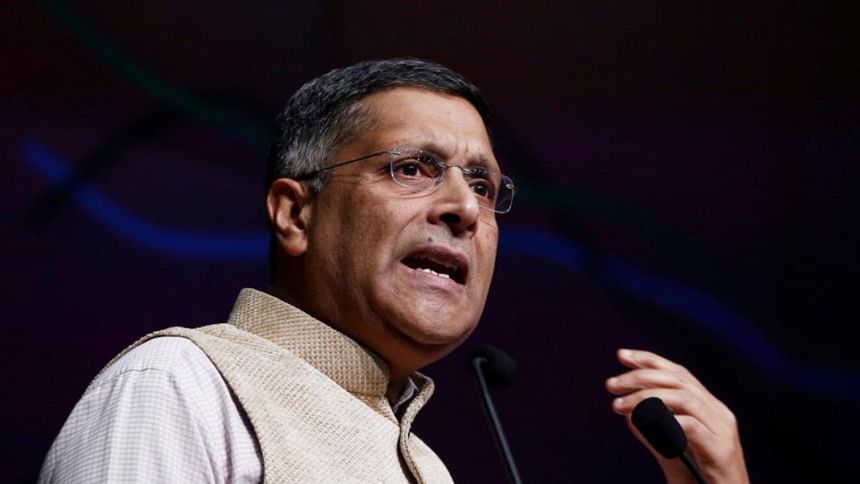Can we take some pointers?

The annual budget of the central government of India is immediately preceded by an Economic Survey, designed to provide the background to the budget decisions. The budget itself, presented on February 1, with its immediate consequences for all Indian citizens and tax payers, usually rather overshadows the Economic Survey. Both are always of great interest to India's neighbour countries, yet for Bangladesh the latter should this year be of particular interest and value.
This latest 2017–18 Economic Survey, presented by Chief Economic Adviser, Arvind Subramanian and his team, is exceptional on two counts. Firstly, it is able to draw on an unprecedented range and amount of data drawn from the massive spread of digitalisation, including the Aadhar biometric identification of nearly the entirety of the huge population and the increasing recent success of the amended General Service Tax (GST) in expanding tax registration. Analysis of this data has enabled much better and more up to date understanding of the Indian economy.
Secondly, it has also enabled a remarkable expansion of the survey into the complexities of the socio-economic background to the bare economic statistics and analysis. This includes the likely effects of climate change on Indian agriculture, the extent, causes and social consequences of the growing male/female imbalance in India's youth and the way most of India's economic growth is captured by a tiny rich minority. It illustrates the lamentable quality of Indian education and the very low expenditure on it and on R&D as shares of GDP.
Despite the disparity in size and seven decades of separate development, India and Bangladesh still share many social and economic characteristics and can learn from each other's experiments, successes and failures. Both are experiencing the rush to urbanisation, the information revolution, the problems of providing jobs for the young millions entering the work force and many complex social tensions between the forces of modernisation and conservatism. Both have democratic parliamentary systems and political parties which reflect these massive changes in their societies and continual dangers of freedom of press, adequate political space for oppositions and independence of key institutions.
Such similarities must not be over emphasised. To take one example, in India the GST is an attempt to move towards a single internal market, replacing the state border taxes and delays which enormously increase transport costs and hamper the development of new medium size firms. This has been difficult as states relied heavily on such levies for their own revenues. Bangladesh already has such a single market and need only concentrate on improving its communication infrastructure.
Useful comparisons can be made in this general field of taxation. Both India and Bangladesh have low levels of tax revenues compared to many other developing countries, let alone developed ones. Yet their governments cannot avoid having to take the lead in funding the enormous sums required both for infrastructure for growth and for attempting to raise the questionable quality and range of education, skills training and health services.
Both face difficulties of corruption, tax evasion and capital flight. Both are finding new tools in digitalisation, VAT extension etc and report some success. Subramanian estimates that tax revenues, following demonetisation and GST implementation will stabilise about 12 percent higher. Our Finance Minister Muhith seeks similar revenue growth in Bangladesh. Some politicians in both countries are realising that the citizen's readiness to pay tax, at central or local levels, relates not only to tax fine tuning and the effectiveness of collection but also to the degree of his or her perception of good and effective governance. Tax fine tuning can only be effective in combining revenue growth with encouragement of entrepreneurship growth. This is based on expert analysis of up to date data. Recent revelations have cast worrying doubt on the reliability of BSS data.
Both India and Bangladesh are still dependent on agriculture, for employment. The Economic Survey documents the extent to which male movement to find urban or overseas employment is leading to the "feminisation" of Indian agriculture—often in entrepreneurial leadership as well as in labour. How far is this also a Bangladesh phenomenon? Agriculture in both countries has always been heavily influenced by monsoons and natural disasters but now faces the gradual impact of climate change. Subramanian here has access to an unusually wide range of survey data which points to a 20 percent to 25 percent loss in farm income in the medium term as temperatures and extreme weather events increase. He advocates to greatly increase the proportion of India's irrigated land area and a focus on modern sprinkle and drip irrigation, particularly given the lowering of north India's water tables. Some areas of Bangladesh are comparatively water rich but we face our own problems of salination etc. Facing climate change, both countries need scientific and political collaboration on water issues which range far beyond even that of the Teesta.
One last surprising example from the Indian Economic Survey treasure trove of new data and analysis relates to gender bias. Although there are exceptions in tribal groups committed to matriarchy, it has long been recognised that in much of India the birth of a boy is generally strongly felt as a blessing and that of a girl child as a future dowry burden. The preference for at least one son to care for parents in old age, with the modern ability to establish the sex of the unborn child for medical termination has led to a huge gender imbalance in India's young population and "missing girls" in tens of millions. Expert analysis of data shows that 65 percent of male births are that of the family's last child.
These findings come at a time when India is already concerned over horrific cases of gang rape and child sexual abuse. The growing shortage of young women, combined with traditional barriers to sexual experience is building up dangerous levels of male frustration. Again, how far are there similar trends in Bangladesh? We know family violence, abandonment of wives is common but also stringent laws are in place against harassment of women/girls. What can our predominantly Muslim country teach India and what can we learn from their debates?
Selina Mohsin is a former ambassador.





Comments